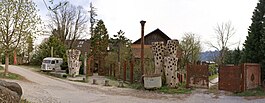Rubigen
| Rubigen | ||
|---|---|---|
 |
||
|
||
| Coordinates: 46°54′N 7°33′E / 46.900°N 7.550°ECoordinates: 46°54′N 7°33′E / 46.900°N 7.550°E | ||
| Country | Switzerland | |
| Canton | Bern | |
| District | Bern-Mittelland | |
| Area | ||
| • Total | 6.93 km2 (2.68 sq mi) | |
| Elevation | 549 m (1,801 ft) | |
| Population (Dec 2015) | ||
| • Total | 2,920 | |
| • Density | 420/km2 (1,100/sq mi) | |
| Postal code | 3113 | |
| SFOS number | 0623 | |
| Surrounded by | Allmendingen, Belp, Münsingen, Trimstein, Worb | |
| Website |
www SFSO statistics |
|
Rubigen is a municipality in the Bern-Mittelland administrative district in the canton of Bern in Switzerland.
Rubigen is first mentioned in 1267 as Rubingen.
The oldest traces of a settlement in the area include scattered neolithic and Bronze Age items and La Tene tombs. The remains of a Roman era fountain and an early medieval cemetery have also been found. During the Middle Ages, the village was part of the Herrschaft of Münsingen. The rulers of Münsingen built a fort near the village around 1278. Very little is known of the history of the fort, but it fell into ruins was demolished in 1798. During the 15th century, the village broke away from the Herrschaft and in the following century it became subject to the city of Bern. Due to its proximity to the city Bernese patricians built their summer homes in the area.
The hamlet of Beitenwil was first mentioned in 1328 as Beitenwile. It was originally owned by Fraubrunnen Abbey. However, in 1473, it was acquired by the Herrschaft of Worb and was combined with Trimstein. In 1834 the three school districts of Rubigen, Allmendingen and Trimstein merged to form the political municipality of Rubigen. These three would remain politically united until 1993.
The roads and fields around the village were often damaged when the Aare river flooded. The Jura water correction projects of 1824-31 finally controlled the river and allowed the villages to expand their infrastructure. The Hunzigen bridge was built in 1836 to replace several ferries. Despite the improved roads and the bridge, the villages remained generally small and rural. Even the completion of a train station on the Bern-Thun railroad in 1859 did not lead to growth. The municipality's population only began to grow in the 1960s. The completion of the A6 motorway in 1973 encouraged further growth. Today many of the residents of the municipality commute to jobs in nearby cities.
...
Wikipedia




